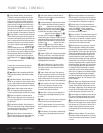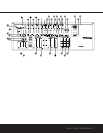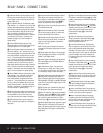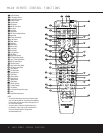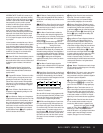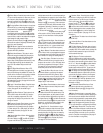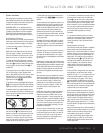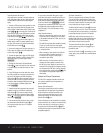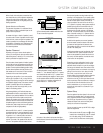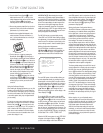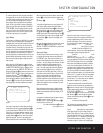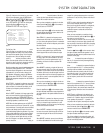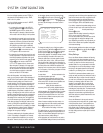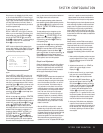
14 INSTALLATION AND CONNECTIONS
INSTALLATION AND CONNECTIONS
Video Equipment Connections
Video equipment is connected in the same manner as
audio components. Again, the use of high-quality inter-
connect cables is recommended to preserve signal
quality.
1. Connect a VCR’s, personal video recorder’s or other
video source’s audio and video Play/Out jacks to the
Video 1/Video 2 Audio/Video and/or S-Video Input
Jacks
eh on the rear panel. The Audio and
Video Record/In jacks on the VCR should be connect-
ed to the
Video 1/Video 2 Audio/Video and/or S-
Video Output Jacks
gi on the AVR 230.
2. Connect the analog audio and video outputs of a
satellite receiver, cable TV converter, television set or
any other video source to the
Video 3 Audio/Video
and S-Video Input Jacks
k .
3. Connect the analog audio and video outputs of a
DVD or laser disc player to the
DVD Audio/Video
and S-Video Inputs
d .
4. Connect the digital audio outputs of a DVD player,
satellite receiver, cable box or HDTV converter to the
appropriate
Optical or Coaxial Digital Inputs
cf*(.
5. Connect the
Video and/or S-Video Monitor
Output
b jacks on the receiver to the composite
or S-Video input of your television monitor or video
projector.
6. If your DVD player and monitor both have compo-
nent video connections, connect the component out-
puts of the DVD player to the
DVD Component
Video Inputs
›. Even when component video con-
nections are used, the audio connections should still
be made to either the analog
DVD Audio Inputs
or any of the Optical or Coaxial Digital Input
Jacks
cf*(.
7. If another device with component video outputs is
available, connect it to the
Video 2 Component
Video Inputs
‹. The audio connections for this
device should be made to either the
Video 2 Audio
Inputs
or any of the Optical or Coaxial Digital
Input Jacks
cf*(
.
8. If the component video inputs are used, connect
the
Component Video Monitor Outputs fi to
the component video inputs of your TV, projector
or display device.
9. If you have a camcorder, video game or other
audio/video device that is connected to the AVR on a
temporary rather than permanent basis, connect the
audio, video and digital audio outputs of that device
to the
Front-Panel Inputs *(ÓÔ.A device
connected here is selected as the Video 4 input, and
the digital inputs must be assigned to the Video 4
input. (See page 17 for more information on input
configuration.)
Video Connection Notes:
• When the component video jacks are used, the on-
screen menus are not visible and you must switch
to the standard composite or S-Video input on your
TV to view them.
• The AVR 230 will accept either standard composite,
S-Video or Y/Pr/Pb component video signals.
However, it will not convert composite or S signals
to component video.
• When connecting a video source to the AVR 230,
you may use either composite, component or
S-Video, but only one type of video may be
connected for each device.
• When more than one video format is used, it is
necessary to make a separate connection from
the AVR to your video display for each format. For
example, if both composite and component sources
are connected to the AVR 230, both the composite
and component video monitor outputs
fi must
be connected to the appropriate inputs on your
video display.
System and Power Connections
The AVR 230 is designed for flexible use with multi-
room systems, external control components and
power amplifiers.
Remote Control Extension
If the receiver is placed behind a solid or smoked
glass cabinet door, the obstruction may prevent the
remote sensor from receiving commands. In this
event, an optional remote sensor may be used.
Connect the output of the remote sensor to the
Remote IR Input ∞ jack.
If other components are also prevented from receiving
remote commands, only one sensor is needed. Simply
use this unit’s sensor or a remote eye by running a
connection from the
Remote IR Output § jack to
the Remote IR Input jack on Harman Kardon or other
compatible equipment.
AC Power Connections
This unit is equipped with two accessory AC outlets.
They may be used to power accessory devices, but
they should not be used with high-current-draw equip-
ment such as power amplifiers. The total power draw
to each outlet may not exceed 100 watts.
The
Switched AC Accessory Outlet ‡ will receive
power only when the unit is on. This is recommended
for devices that have no power switch or a mechanical
power switch that may be left in the “ON” position.
NOTE: Many audio and video products go into a
Standby mode when they are used with switched out-
lets, and cannot be fully turned on using the outlet
alone without a remote control command.
The
Unswitched AC Accessory Outlet ° will
receive power as long as the unit is plugged into a
powered AC outlet.
Once the
AC Power Cord fl is connected, you are
almost ready to enjoy the AVR 230’s incredible power
and fidelity!
31
35
32
31
32
37
36
34
35
33



